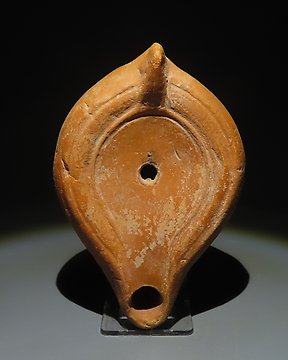
Romain antique Terre cuite Lampe à huile. 1er-3ème siècle après JC. 12,5 cm de longueur.
Nº 83937973

Nº 83937973

ITEM: Oil lamp
MATERIAL: Pottery
CULTURE: Roman, South of Jerusalem
PERIOD: 1st - 3rd Century A.D
DIMENSIONS: 25 mm x 62 mm x 87 mm
CONDITION: Good condition
PROVENANCE: Ex French private collection, acquired before 1980s
Roman oil lamps were essential lighting fixtures in ancient Roman households, temples, and public spaces, providing illumination during the hours of darkness. These lamps typically consisted of a shallow, bowl-shaped reservoir for holding oil, a central filling hole, a spout for the wick, and a handle or handle loops for carrying or hanging. The design of Roman oil lamps evolved over time, with variations in shape, size, and decorative elements reflecting regional preferences and technological innovations. Early Roman lamps were often simple in design, made of clay or terracotta, while later examples became more elaborate, incorporating intricate relief decorations, inscriptions, and figural motifs.
One notable aspect of Roman oil lamps is their widespread distribution throughout the Roman Empire, showcasing the extent of Roman influence and trade networks. Roman oil lamps have been unearthed in archaeological excavations across Europe, North Africa, and the Near East, indicating their ubiquity and importance in everyday life across diverse cultures and regions. The production of oil lamps was not limited to specialized workshops but also occurred in domestic settings, where artisans crafted lamps for local consumption or trade. As a result, Roman oil lamps exhibit a remarkable diversity of styles, reflecting the artistic tastes and cultural influences of the time.
In addition to their practical function as sources of light, Roman oil lamps also held symbolic and ritualistic significance in Roman society. Many lamps were decorated with religious motifs, including depictions of gods, goddesses, and mythological scenes, suggesting their use in religious ceremonies, household rituals, and funerary practices. The act of lighting oil lamps was often accompanied by prayers or invocations, invoking divine protection and blessings. Moreover, oil lamps were commonly used in funerary contexts, placed in tombs as offerings to the deceased or as symbols of hope for the afterlife.
Comes with Certificate of Authenticity and Export license
If you bid outside the European Union and win the item, we will have to apply for an export licence for your country and shipping will take 3 to 5 weeks.
Comment acheter sur Catawiki ?
1. Découvrez des objets d’exception
2. Faites la meilleure offre
3. Effectuez un paiement sécurisé